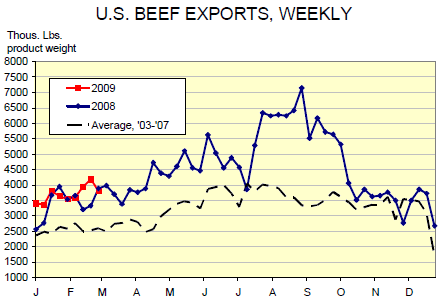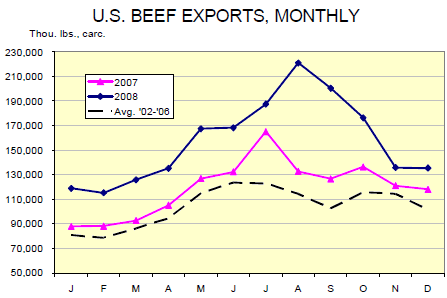



CME: A Lot of Eggs in the Export Basket!
US - CME's Daily Livestock Report for 9 March 2009.A MAJOR discussion topic these days in meat and poultry markets is the status of exports and the discussion is certainly not passing interest — exports are critical to US animal protein sectors. The phenomenal performance of US pork and pork variety meat exports in 2008 — up 57 per cent in volume, up 54 per cent in value and now representing 20 per cent of US production — has been addressed on several occasions in these pages. But 2008 was also a record year for US broiler exports.
The 6.96 billion pounds exported was 17.9 per cent higher than 2007’s total and represented a record 19.1 per cent of net ready-to-cook broiler production. And beef exports, though not record-high due to the continuing recovery from BSE in 2003, were 32 per cent higher than 2007 and represented 7.1 per cent of total production. Clearly, all three of these businesses have much at stake in export markets. Consider what would happen if a significant portion of 2008’s shipments had to be consumed in the US To use a poultry metaphor — Everyone has a lot of eggs in this export basket!
So what is happening this year? That is difficult to tell. Some in the trade report that exports are “dead”, others have told us they are “okay but not great”. No one has provided any glowing descriptions but that is no surprise considering the 2008 yardsticks to which 2009 business will be compared, especially for chicken and pork. And actual data from the Department of Commerce and USDA are delayed six weeks, meaning that we still have no actual data for 2009. The first will be released next Monday.
The only data approaching “real time” that we have is for beef exports. Why the special treatment? Because the industry (both producers and packers) asked for it and got it as part of the Livestock Mandatory Reporting Act of 1999. Chicken was not included in that legislation. Pork was included but pork producers and packers agreed to not pursue weekly export data based on the concern that publication of that information would likely help competitors such as Canada, Denmark and Brazil more than it would help U.S. producers and packers. And don’t scoff at that idea too quickly.
Consider that, in 1999, the US beef sector was producing essentially a unique product for export markets — grain fed beef. Only Canada was a significant competitor. Australia produced a bit but not much until BSE came along in Canada and the US and created a golden opportunity in 2003 and 2004. On the other hand, pork was and is pretty much pork. There is not near as much difference among pork from various suppliers as there was difference between grain fed and grass fed beef. Some now regret that decision by the pork industry and pork producers at their recent annual meeting actually voted to ask USDA to begin mandatory weekly export reporting.
So, only weekly beef export data can give us much of an idea what is going on in US meat and poultry export markets — and it says things are going pretty well (top graph below). Weekly shipments have been hot and cold so far in 2009, but they are 9 per cent higher YTD. The data coming out next Monday is monthly data, so we have provided the 2008 monthly beef export chart to compare to its weekly counterpart. The patterns are clearly similar even though the data cannot be compared precisely — weekly data are in product weight vs. carcass weight for monthly and, of course, months just refuse to operate well on a whole-week basis.










